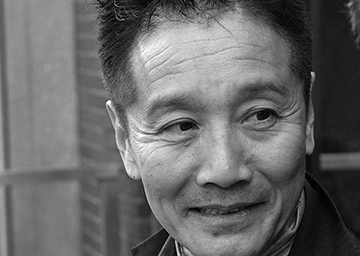Biography
AKIRA HASEGAWA’s the Artist, Akira Hasegawa, was born in Komatsu City, Ishikawa Prefecture, Japan, in 1947.
Since 1973, he has worked on over 4,000 films and television commercials, videos, cyber graphic designs and computer art projects as an artist, producer and director.
These projects include but are not limited to: logo creation and title images for CCTV (China Central Television), NHK TV Japan National Broadcasting Network, the award winning opening title sequences for “Dragon Spirit”, Atlanta Olympics, conceptual videos for EXPO 2005, Aichi, cyber graphics for the Israeli musician Ofra Haza’s and her IMAX music video “I Want to Fly”.
Akira has received numerous awards and prizes including the prestigious award from the TV CM section of NAB Japan (The National Association of Commercial Broadcasters in Japan) and The 2007 Public Art Year in Review (a Recognition Award, the only one of its kind given in America for public art programs).
He was also awarded for his D-K Live installation on San Jose City Hall’s glass dome, August, 2006, during “Zero One San Jose: A Festival of Art on the Edge”. That was his inaugural show in the United States. At the Global Summit for DK’s philosophy and global reach and the fact that it is an environmentally friendly art form on a large scale have set higher standards for any digital art and contributed for its recognition as an Art form in its own category.
What is Kakejiku?
A kakejiku is a traditional Japanese art work on a hanging scroll, seasonally replaced to honor a guest. In “The Way of Tea” (Chanoyu), at a Tea House for a traditional ceremonial presentation of green tea, there is no other interior decoration but a kakejiku. In “The Way of Tea”, which was influenced by Zen Buddhism, a kakejiku symbolizes a view of the Universe.
Hasegawa is a lecturer on high-tech arts, the concept of time in cyberspace, intellectual technology and other subjects related to science and technology, speaking at such institutions as the Japanese Ministry of Culture, Science & Technology and many universities.
He is a consultant to the Tokyo University of Technology, NHK (Japan National Broadcasting) Computer Graphics Center, advisor to the Japan-China Project and Art Director/Producer for the International Internet- Robotics Society. Last year DK was featured in German University Architectural Textbook. Information about Akira Hasegawa’s contribution to Media Art is included in “Media Facades: History, Technology, Content” by M. Hank Haeusler, For his work and D-K Live exhibition at San Jose City Hall, he has received prestigious award. ISEA (International Symposium on Electronic Art) 2006, Zero One/San Jose: A Global Festival of Art on the Edge, August 8-13, 2006 by turning the new, Richard Meier designed City Hall into “a Kaleidoscope at Night”, during the conference. That installation was included in The 2007 Public Art Year in Review, presented at the Americans for the Arts Annual Convention on June 3rd, in Las Vegas, NV. The award, which celebrates the most successful, innovative and exciting public art projects in the United States, is granted by The Public Art Network (PAN), whose artist jurors this year, Larry Kirkland and Miwon Kwon have chosen 400 projects out of over 300 entries. This Recognition Award is the only award presented in America for public art projects; one Hasagawa has won for his first installation in the United States. For the past 5 years DK and Akira Hasegawa have received worldwide coverage in numerous reputable press publications, radio broadcasts, TV shows, film series and web sites.
Hasegawa san reached his notoriety for inventing a new type of art called Digital Kakejiku, as well as, a new machine which he describes as a “sensitizing instrument” which lights up a large area (architectural or natural surroundings) with random sequences of abstract images which are constantly changing at a very slow pace. Hasegawa’s firm, CPM studio inc., with its state of the art computer generated cyber graphics laboratory, is located in the KOMATSU city of Komatsu, in Ishikawa Prefecture. A city with a long cultural and artistic tradition, Komatsu today is a center of machinery, equipment and technology manufacturing, with ten universities, many specializing in high technology research. He resides there, the city of his birth, with his wife and two children, who are away at universities.
Sessions
Sept. 19 • 14:30 – 15:30

